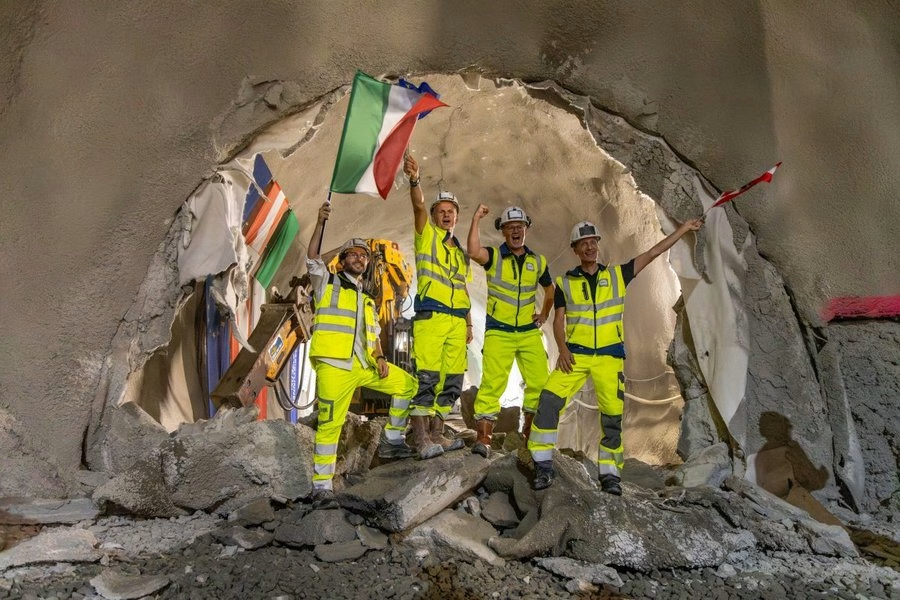Workers broke through the final layer of rock on Thursday, linking Austria and Italy underground through the Brenner Base Tunnel. This new connection marks a decisive milestone in creating the world’s longest railway tunnel.
Italian Prime Minister Giorgia Meloni, present at the ceremony, called it “a historic day for Italy, Austria, and Europe.” The breakthrough opens the first direct rail tunnel between the two countries.
The tunnel will be 55 km long and extend to 64 km once linked with the existing Innsbruck bypass. Travel between Fortezza in Italy and Innsbruck will drop from 80 minutes to under 25.
Costs have risen to €8.5 billion (£7.3 billion), about €2.5 billion over budget. Completion is set for 2032, almost 16 years later than first planned.
The Brenner Pass is one of Europe’s busiest freight routes, with 2.5 million lorries and 14 million cars crossing each year. At present, 70% of goods move by road and only 30% by rail. The tunnel aims to reverse this balance, shifting freight from road to rail to cut emissions and ease pressure on Alpine communities.
However, the project’s success depends partly on Germany. Northern access routes are not yet finalised, raising concerns about delays in fully connecting the corridor.
Europe’s engineering ambitions are mirrored across the continent, with the UK recently completing the Colne Valley Viaduct, the country’s longest railway bridge. Like the Brenner Base Tunnel, this project showcases how modern infrastructure can combine efficiency, sustainability, and design, reshaping transportation corridors and connecting communities over challenging terrains.
Last concrete ring for the H41 Sill Gorge-Pfons construction site rolled off
Reported September 4 – BBT SE announced on July 19 2025, that the last concrete ring for the “H41 Sill Gorge-Pfons” construction site has rolled off the line at the Ahrental factory. The plant, which started operating in February 2023, produced over 59,000 tubbing rings for the Austrian section of the Brenner Base Tunnel. The rings form the final lining of the main rail tunnels and are installed directly by the tunnel boring machines (TBMs) during excavation.
The factory was built on-site because the construction site had no rail line for deliveries. ARGE H41, the temporary consortium managing the works, set up a production line that divided the process into moulding, reinforcement, concrete, and curing phases. An internal transport system ensured a smooth workflow, high quality, and cost efficiency. After storage, the rings were carried into the mountain using a specially developed vehicle and train before being installed by the TBMs.
Producing the rings on-site significantly reduced transport needs. If the rings had come from elsewhere, around 29,500 lorry trips would have been required. Instead, only 3,000 trips took place to supply materials and steel reinforcement. Romed Insam, project manager for Lot H41 Sill Gorge-Pfons, said the approach limited disruption to local communities and demonstrated that large infrastructure projects can be both efficient and environmentally responsible.
Tunnel boring is also nearing completion. Two Herrenknecht TBMs, Ida and Lilia, have been operational since summer 2023 and are travelling just under 17 km toward Navis. TBM Ida finished its drive in late August, while Lilia is expected to finish in autumn. This will mark the end of mechanized excavation for Lot H41, a key milestone on the path to completing the Brenner Base Tunnel.
Italian Side of Brenner Base Tunnel Reaches Austrian Border
May 2025 – The Webuild-led team has completed tunnelling on the Italian side of the Brenner Base Tunnel, reaching the Austrian border with TBM “Flavia”. Once finished, the tunnel will connect Fortezza in Italy to Innsbruck in Austria, cutting travel time from 80 minutes to 25 and allowing trains to run at speeds of up to 250 km/h. Progress on Lot Mules 2–3 now exceeds 95%, while work continues on other Austrian sections and the Isarco Underpass near Fortezza.
Isarco River underpass section completed after 8 years
Reported on August 2023 – The construction of Lot H71 or rather the Isarco River underpass section of the Brenner Base Tunnel has been completed after 8 years of construction. Designed by Rocksoil, this section which is entirely within Italy, was built by a joint venture featuring WeBuild, Strabag, Consorzio Integra and Collini Lavori, at a cost of £260M.
The scope of the project comprised the construction of 4.5km of main tunnels and 1.5km of tunnels that connect to the existing Brenner mainline. Reportedly, the work was demanding despite the relative shortness of the tunnels. This is because of the “highly complex” construction methods involved, particularly developing the tunnel beneath the Isarco River, the A22 motorway and the SS12 state road.
The project also involved rerouting of the SS12 road, and the construction of bridges over the Isarco River and the Rio Banco. Additionally, the works involved the construction of a cargo loading area on the A22 so as to allow the transport of materials. The Verona – Brenner mainline was also moved by approximately 1000 meters to allow the construction of the Isarco River underpass section.
This section now links the Brenner Base tunnel to the existing Brenner line and the Fortezza train station.
Overview of the Brenner Base Tunnel
Brenner Base Tunnel (BBT) is a twin-tube, straight, flat underground railway tunnel that is currently under construction. The tunnel is being built through the base of the Eastern Alps beneath the Brenner Pass.
Preparation for the construction of the tunnel began back in 1999 while the actual construction began in 2011. The project is expected to be completed in 2032 at a total cost of more than US$ 91 billion. It will connect Innsbruck, the capital of Austria’s western state of Tyrol and Fortezza, a commune in South Tyrol, northern Italy.
Features of the BBT
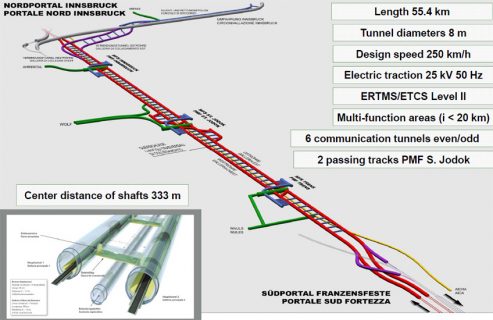
The main tunnel, 55 kilometres long, begins in the Innsbruck suburb of Wilten. It penetrates the Alps reaching a height of about 840 meters above sea level. The tunnel will be up to 1,720 meters below the surface at its deepest point in the gneiss section stretching south from the Italian border.
Also Read: New Brno Main Train Station project timeline and all you need to know
In the case of unforeseen events, the tunnel has three emergency stopping areas. These areas are located at Trens (in Freienfeld), St. Jodok, and towards the northern end of the tunnel. Here trains can halt underground in the tunnel. The two tubes (each 8.1 m wide, running 40 to 70 m apart from one another) are linked every 333 meters. They are linked by connecting side tunnels that can be used in case of emergency as escape routes. ETCS Level 2 will be installed to provide train control.
On its north end, the BBT has two entrances that will go underground a few kilometres before the junction with the main tunnels. One of the two entrances leads from the main Innsbruck station under Bergisel and the other connects with the Innsbruck bypass.
About two-thirds of the entire tunnel construction will be undertaken through tunnel boring machines and the remaining (one-third) through cyclical and conventional methods e.g. explosives, mechanical diggers with hydraulic hammers, and drilling equipment.
Upon completion, the BBT is expected to become one of the longest continuous railroad tunnels in the world. It will have the capacity to withstand a weight of 400 trains (222 goods trains and 42 passenger trains in the base tunnel) and it will allow trains to cross the Alps much faster. The goods trains will run at a speed of 160km/h, and the freight trains at 250 km/h, reducing the travel time between the two regions from 2 hours currently to 50 minutes roughly.
Brenner Base Tunnel (BBT) Project Timeline
2007
In July, Austria and Italy signed a memorandum of understanding to support the Brenner Base Tunnel (BBT) for shifting the traffic from road to rail.
In the summer of the same year, work started on a pilot tunnel to run along the line of the future tunnel and to be used for removing water and spoil during the major BBT construction phase.
2008
The project was submitted for authorization in the spring of 2008.
2014
In October the southern construction lot of the Brenner Base Tunnel was awarded to the Isarco consortium composed of Webuild (formerly Salini Impregilo), Strabag AG, Strabag S.p.A., Consorzio Integra, and Collini Lavori.
In May, the government approved and gave the go-ahead for the project.
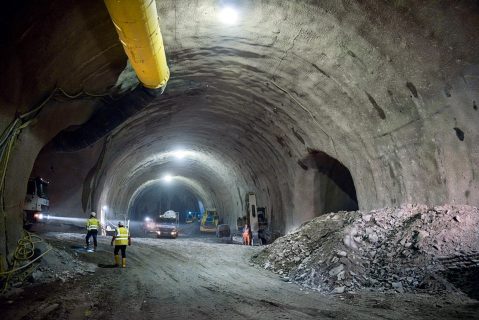
2019
In July, two Austrian segments were connected, and an unbroken 36 km long tunnel (approximately 65% of the tunnel’s entire BBT length) was formed.
2020
In October, the project’s contractor, (Austro-Italian tunnel construction company Brenner Basis Tunnel (BBT SE), which is jointly owned by Austrian and Italian national rail infrastructure managers ÖBB and RFI), cancelled a key contract to construct the 18km section known as Lot H51 between Pfons and the border at Brenner.
The contract also included around 9km of exploratory tunnelling, an emergency access adit, and an underground emergency evacuation halt at St Jodok.
2021
In March, infrastructure manager Italian Rail Network (RFI) awarded a 51:49 consortium of Webuild and Implenia a €1.07bn contract to design and build a 22km high-capacity railway between Fortezza and Ponte Gardena to increase capacity at the southern end of the Brenner Base Tunnel.
In the same month, Austrian-Italian BBT SE announced an average daily advance rate of 27.7m for “Virginia” with a best daily performance of 36.75m.
November 2021
Webuild Group and its Swiss subsidiary CSC in a joint–venture with Swiss partner Implenia were awarded a close to US$ 737.5M contract to carry out works on Lot H41 Gola del Sill-Pfons on the Austrian side.
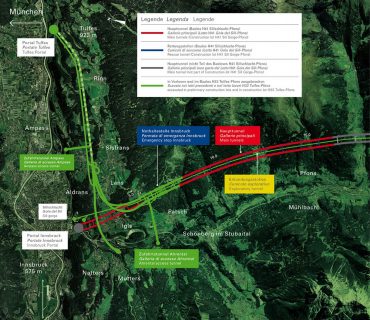
The scope of works includes the construction of the railway from Gola del Sill near the city of Innsbruck in the north to the town of Pfons located further south, the excavation of an approximately 7.3km tunnel, and auxiliary tunnels using traditional methods, and the excavation of another 16.5km using mechanized methods.
It also includes the lining of the walls of completed tunnels, an underground emergency stop at Innsbruck, access tunnels, exploratory tunnels, and parts of other secondary tunnels.
Late November 2021
A new milestone was reached in the Brenner Base Tunnel project following the excavation of more than 14 kilometres within a span of three and a half years. The 14km long tunnel was dug by the Tunnel Boring Machine (TBM) dubbed “Serena”.
Reportedly, Serena has a diameter of 6.85m, a length of nearly 300m, a weight of 1,500t, and a driving power of 2,800kW. The TBM dug through at least 4km of rock every year along the 14km route that ends at Brenner.
The milestone marks the end of work on the exploratory tunnel on the Italian side of the tunnel, and it brings the excavation to 82% on Lot Mules 2-3, the biggest construction lot of the project.
December 2021
During the December Tunneling Festival conference, Alberto Paddeu, the BTC JV senior project engineer stated that all three tunnel boring machines (TBMs) deployed on the Mules 2-3 lot of the Brenner Base Tunnel (BBT) were progressing as scheduled. It was just a few weeks after BTC JV had completed the section’s exploratory tunnel on time after three and a half years of tunnelling.
On the main west tunnel, completion was at 67%, excavating 9.5km, while the main east tunnel was 75% complete, at 10.5km. Paddeu revealed that the tunnelling will be completed by the end of next year.
January 2022
Brenner Base Tunnel’s largest construction lot has gotten off the ground. This involves work on Lot H41 Gola del Sill-Pfons. The tender, worth €651m, was on November 2021 awarded to a joint venture comprising Webuild and its Swiss subsidiary CSC Costruzioni, which has a 50% stake, as well as the Swiss Implenia, also with a 50% share. A European public limited company BBT is the project’s client. The latter was created for railway tunnel development between Austria and Italy under the Alps.
Lot H41 involves a part of the mega project in Austria and comprises the building of the railway between Gola del Sill, close to Innsbruck, south, and the town of Pfons. Additionally, it will lead to the construction of 22.5km of main tunnel tubes as well as 38 cross passages all with a length totaling around 2.3km. Lot H41 will be accessed mostly from the current Ahrental lateral access tunnel and work is set to be completed in summer 2028.
Read also: Construction to begin on Dover Fastrack rapid bus transit route
Brenner Base Tunnel’s environmental sustainability
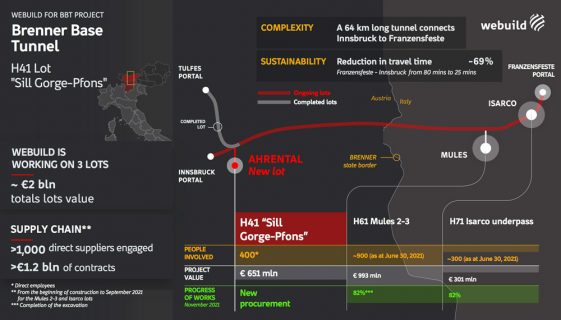
Two TBMS sets to carry on the excavation have a diameter of over 10m. The project design aims at environmental sustainability during development and measures include the logistics of the work sites modelled to lower travel times for the transport of materials as well as noise and dust reduction. Other lots still to be constructed at the Brenner Base Tunnel include Lot H71 Isarco River Underpass and Lot H61 Mules 2-3. Webuild has already completed constructing the 43.3km Lot 33 Tulfes-Pfons. The construction specialists are also working on the railway from Fortezza to Ponte Gardena on the southern side of the tunnel.
Upon completion, the Brenner Base Tunnel will become the world’s longest railway tunnel at 64km. It will be an important part of the Scandinavian-Mediterranean Corridor of the Trans-European Transport Network (TEN-T) which will link Helsinki in Finland with La Valletta in Malta. It also plays a crucial part in linking Italy with Austria with a high-speed/high-capacity railway.
Jun 2022
Brenner Base Tunnel: Construction of a 24.1km tunnel connecting Fortezza to Brenner Completed
A 24.1-kilometre-long tunnel connecting the southern portal at Fortezza to the Brenner has been completed. This work is part of the 64-kilometre Brenner Base Tunnel, which will connect the Italian town with Innsbruck in Austria and become the world’s longest railway tunnel.
This milestone was achieved with the breakthrough of a diaphragm separating section, the H71 Isarco River Underpass is being built by We Build, and Mules 2-3 are being built on the Italian side of the project by Webuild and Ghella. In addition to the main tunnels that will allow high-speed/high-capacity trains to pass through, the project envisions a network of 230 kilometres of tunnels and spaces, 151 kilometres of which have already been excavated.
This intricate underground network, the deepest point of which will be 1,700 meters below the mountain range peaks, will have passenger trains travelling at speeds of up to 250 kilometres per hour and cargo trains travelling at 160 kilometres per hour.
Significance of the Brenner Base Tunnel project
The project is strategically important for the TEN-T, a high-speed/high-capacity network that will transport people and goods across the continent. It will significantly reduce CO2 emissions by facilitating sustainable mobility among member countries by shifting more people and cargo from road to rail.
The Brenner Base Tunnel will be part of the Scandinavian-Mediterranean Corridor, which will connect the transportation systems of Helsinki, Finland, and La Valletta, Malta.
Webuild is involved in four lots of the Brenner Base Tunnel project, which is more than any other company. Webuild is working on H41 Gola del Sill-Pfons after completing the Tulfes-Pfons on the Austrian side, in addition to H71 Isarco River Underpass and H61 2-3 Mules. Up to 1,600 workers are expected to be employed on the three remaining construction lots, sections H61 and H7, which involve over 1,000 suppliers and service providers, nearly all of whom are local.
Dec 2022
Brenner Base Tunnel project enters major phase for bridges across Sill Gorge
The construction of two bridges across Austria’s Sill Gorge as part of the Brenner Base Tunnel is underway. The job is described as a “major engineering challenge.” With a length of 64 kilometres, the Brenner Base Tunnel will be the world’s longest railway tunnel. It will connect Verona, Italy, to Munich, Germany, via Innsbruck, Austria, and will run beneath the Alps.
Lot H21 of the project, which connects the city of Innsbruck to the mouth of the Brenner Base Tunnel, is managed by Austrian firm Porr Group under a €59.5M contract. It presents some of the most difficult logistical and construction challenges. However, it is described as the project’s shortest lot (approximately 600m).
Excavation for two cut-and-cover tunnels to the east side of the gorge crossings, which began in August 2020, has already been completed. Lot H21 of the project has a 120m tunnel to carry eastbound trains out of Innsbruck. This is as well as a 130m tunnel to carry westbound trains into the city.
As the line continues east, the two tracks merge to form one railway deck. The 50m-long dual bridges that will carry the railway across the gorge above the Sill River are now the focus of attention.
Read Also: Plans approved for Keadby 3 carbon capture power station in UK
Lot H21 of the Brenner Base Tunnel project
The bridges are 9 meters high and have a composite steel truss and girder structure. One will be an open steel trellis and the other will be enclosed. They are intended to be uniformly embedded in the landscape. Thus, they will be able to minimize the visual and physical impact on the popular hiking destination for both locals and tourists.
The gorge’s narrowness makes construction difficult. Furthermore, the area is densely packed with infrastructure that cannot be affected. These include the A12 Inntal Highway, the A13 Brenner Highway, and the Tirol Panorama Museum. There is also the Untere Sill power plant and the existing ÖBB railway line within the Berg Isel tunnel.
The bridges will link to the future northern portal of the Brenner Base Tunnel, which will be a critical rail junction. Lot H21 is therefore expected to be finished by the end of 2024. “[The construction of the two bridges is] a major engineering challenge,” Brenner Base Tunnel project manager Martin Keinprecht said.
Simultaneously, it is critical to preserve a unique area such as the Sill Gorge, which is popular with residents of Innsbruck and beyond.”
